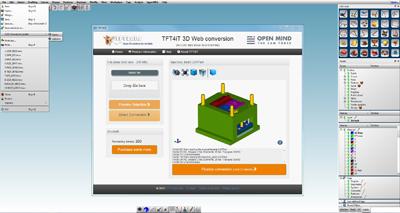
Working in cooperation with the French company, TFTLabs SAS, OPEN MIND Technologies AG has developed a CAD conversion interface that converts CATIA V5 data to hyperCAD-S data both quickly and flexibly.
The new CAD conversion portal is especially designed for users who only need to transfer models occasionally and companies that are not yet in a position to assess their future conversion volume. The interface is a ‘Service-on-Demand' that is called only when it is actually required. Costs are therefore only incurred when the service is used and users are charged on an appealing pay-per-use basis.
The conversion portal is fast and simple to use. Clicking the "CAD Conversion Portal" tab in hyperCAD-S opens a menu window for selecting the CATIA V5 models. Before the model data is converted the user is shown a 3D preview. If everything is correct, the conversion can start. The data is immediately available for processing in hyperCAD-S. The interface is a cloud service that downloads the conversion software. This means that the actual transfer of data always takes place on the user's local computer. The user can be certain that no CAD models are transferred. In addition, the web-based ‘Transfer-on-Demand' always ensures that the latest conversion software is used.
"There is always enormous pressure to adapt CAD data conversion software. Our new on-demand interface allows us to offer hyperCAD-S users, who only need to convert CATIA V5 models occasionally, a flexible solution with no up-front licensing costs," explains Hagen Rühlich, Technical Director at OPEN MIND. And François Chrétien, Chief Scientist at TFTLabs SAS, adds: "We are pleased to have been able to convince OPEN MIND of the benefits of our ‘Open 3D solution for the Web'. OPEN MIND can rely on our over 20 years of experience in the area of interoperability."
The partners' plan for the future is to expand their offering and support other CAD formats in addition to CATIA V5.
Related Glossary Terms
- computer-aided design ( CAD)
computer-aided design ( CAD)
Product-design functions performed with the help of computers and special software.






